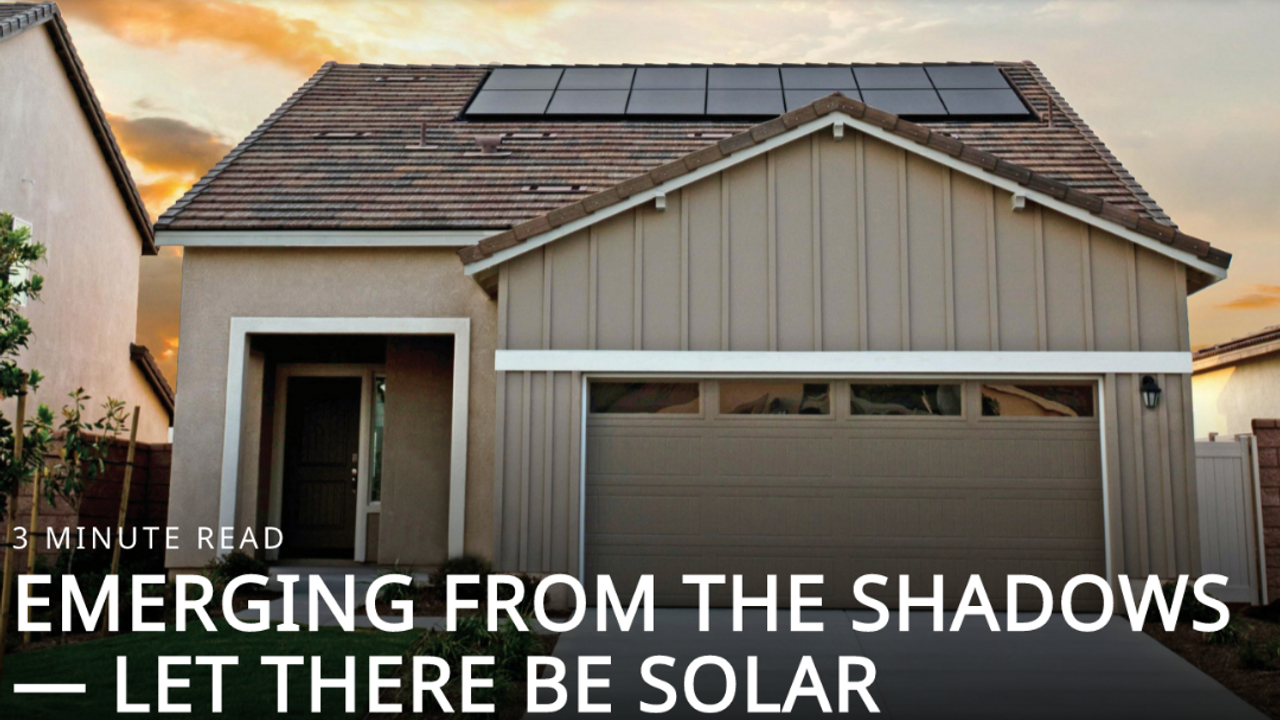EMERGING FROM THE SHADOWS— LET THERE BE SOLAR
Aug 16, 2021
ESTABLISHING POLICIES FOR SOLAR ENERGY SYSTEM INSTALLATION REQUESTS
BY: JONATHAN R. DAVIS, ESQ.
This article first appeared in CAI-GRIE, Connect Magazine: 2021-Issue 3. To read more, click here.
After many months of shutdowns, stay-at-home orders, and quarantines brought on by the COVID-19 pandemic, Americans have been forced to use their homes increasingly and in different ways. This fueled a boom in home improvement projects, including solar energy installations. In 2020 alone, such installations reached a record high in the United States, growing 43% over the prior year, according to CNBC. That massive growth is projected to accelerate as our society emerges from the pandemic.
The expected growth in solar energy installations aligns with falling costs for solar panels, which have dropped 70% since 2014, per U.S. Dept. of Energy statistics. A recent report by the Solar Energy Industries Association and Wood Mackenzie also attributes such expected growth to economic stimulus packages associated with the pandemic, including a recent two-year extension of the investment tax credit (ITC), which was extended in December 2020 as part of the United States’ coronavirus relief and government spending package. Additional government incentives to encourage the use of solar energy systems are expected. California has expressed in Civil Code sections 714 and 714.1 a policy of promoting and encouraging the use of solar energy systems and removing obstacles to installation, which policy is reflected in the Davis-Stirling Act at Civil Code sections 4700(b) and 4746.
Consequently, California associations should expect to see solar installation requests continue to increase, including requests for installation in common areas. As such, association managers and directors must be prepared to navigate such requests in compliance with California law, while also protecting the association’s interests.
California bars associations from imposing requirements that effectively prohibit or restrict the installation or use of solar energy systems; associations cannot cause a reduction in their efficiency by more than 10% or increase their costs by more than $1,000. (Civil Code §714.). Nonetheless, associations may still impose reasonable restrictions on solar energy systems, such as rules requiring the systems to meet applicable health and safety standards and state and local permit requirements.
Associations violating these laws may be held liable to the applicant for damages and, where the violations have been deemed willful, required to pay a civil penalty up to $1,000. (Civil Code §714(f).) The prevailing party in any action to enforce compliance with these statutes is also able to recover reasonable attorney fees. (Civil Code §714(g).) As such, it is extremely important that associations have policies in place to respond to member requests to install solar energy systems, with particular emphasis on requests for installation in common area.
As a starting point, an association’s policies should address the Civil Code section 4746 language pertaining to installation of solar energy systems in common area – typically roofs, garages, and carports. The policy should include a requirement that applicants notify each owner of a unit in the building on which the solar energy system will be located and that the applicant and each successive owner maintain liability insurance coverage at all times. (Civil Code §4746(a).)
Similarly, an association’s policies for rooftop solar installations should consider reasonable provisions that (1) require the applicant to submit a solar site survey showing the placement of the solar energy system prepared by a licensed contractor or registered salespersons [this survey cost is not deemed part of the “cost” of the system for the purposes of determining if the requirements increase the cost by more than $1,000]; and (2); the solar site survey include a determination of an equitable allocation of the usable solar roof area of all owners sharing the same roof, garage, or carport. (Civil Code §4746(b).)
Moreover, an association’s solar energy system policies should address the owner’s installation responsibilities. This might include a maintenance and indemnity agreement requiring the owner and successive owners to be responsible for (1) costs for damage to the common area and/or separate interests resulting from the installation, maintenance, repair, removal and replacement of the system; (2) costs for ongoing maintenance, repair, and replacement of the system until such time as it has been removed and the common area and/or separate interests are restored; and (3) disclosure to subsequent owners of such obligations.
Establishing these policies early should help smooth the process as associations deal with inevitable inquiries about solar energy system installation. If the pandemic has taught us anything, it is that we can never be too prepared.

Jonathan R. Davis Esq. is a Senior Associate attorney with Richardson|Ober LLP, serving common interest developments throughout California.





